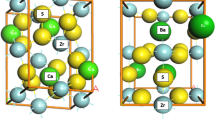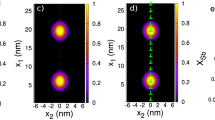Abstract
The orientation of the plane of modulation of the e-plagioclase superstructure appears to be defined by minimization of interface energy during spinodal-like unmixing of preexisting high plagioclase. Computations with strain-free high-temperature lattice parameters show that the plane of minimization of interface energy for the unmixing of anorthite from calcic plagioclase lies in the zone of s vectors [34, 8, 22] (Ab cell) and is rotated about 15° beyond the orientation of the An 75 superstructure. In contrast, the corresponding plane for unmixing of high albite from sodic plagioclase is rotated about 15° beyond the orientation of the An 25 superstructure. The orientation of individual intermediate plagioclase superstructures is the resultant of the proportional constraints acting on anorthiteplagioclase and albite-sodic plagioclase interfaces. The modulation period (S=1/‖s‖) at any composition is approximately equal to the modulation translation distance parallel to [−21, 39, −55] resolved onto the modulation direction.
The structural consequences of the present study are consistent with the essential features of the crystal structure model of Kitamura and Morimoto. However, the e-plagioclase superstructure is considered to represent a category of unmixing phenomena, rather than atomistic ordering, and it seems inappropriate to attempt to describe it with a composition-related supercell.
Similar content being viewed by others
References
Bollmann W, Nissen HU (1968) A study of optimal phase boundaries: The case of exsolved alkali feldspars. Acta Crystallogr Sect A 24:546–557
Bown MG, Gay P (1958) The reciprocal lattice geometry of the plagioclase felspar structures. Z Kristallogr 111:1–14
Cahn JW (1968) Spinodal decomposition. Trans Metall Soc AIME 242:166–180
Chao SH, Taylor WH (1940) Isomorphous replacement and superlattice structures in the plagioclase felsaprs. Proc R Soc (London) Ser A: 176:76–87
Fleet ME, Bilcox GA, Barnett RL (1980) Oriented magnetite inclusions in pyroxenes from the Grenville province. Can Mineral 18:89–99
Fontaine D de (1975) k-space symmetry rules for order-disorder reactions. Acta Metall 23:553–570
Gay P (1956) The structures of the plagioclase felspars: VI. Natural intermediate plagioclases. Mineral Mag 31:21–40
Grove TL (1977) A periodic antiphase structure model for the intermediate plagioclases (An33 to An75). Am Mineral 62:932–941
Grundy HD, Brown WL (1969) A high-temperature X-ray study of the equilibrium forms of albite. Mineral Mag 37:156–172
Grundy HD, Brown WL (1974) A high-temperature X-ray study of low and high plagioclase feldspars. In: MacKenzie WS, Zussman J (eds) The feldspars Proc NATO Advan Study Inst University Press, Manchester pp 162–173
Jaffe HW, Robinson P, Tracy RJ (1975) Orientation of pigeonite exsolution lamellae in metamorphic augite: correlation with composition and calculated optimal phase boundaries. Am Mineral 60:9–28
Kitamura M, Morimoto N (1975) The superstructure of intermediate plagioclase. Proc Jpn Acad 51:419–424
Kitamura M, Morimoto N (1977) The superstructure of plagioclase feldspars: A modulated coherent structure of the e-plagioclase. Phys Chem Minerals 1:199–212
Korekawa M, Horst W, Tagai T (1978) Superstucture of labradorite An∼50. Phys Chem Minerals 3:74–75
Korekawa M, Jagodzinski H (1967) Die Satellitenreflexe des Labradorits. Schweiz Mineral Petrogr Mitt 47:269–278
Landau LD, Lifshitz EM (1958) Statistical physics. Addison Wesley Reading, Mass pp 366–396
McConnell JDC (1974) Electron-optical study of the fine structure of a schiller labradorite. In: MacKenzie WS, Zussman J (eds) The feldspars. Proc NATO Advan Study Inst University Press, Manchester pp 478–490
McConnell JDC (1978a) The intermediate plagioclase feldspars: an example of a structural resonance. Z Kristallogr 147:45–62
McConnell JDC (1978b) K-space symmetry rules and their application to ordering behaviour in non-stoichiometric (metal-enriched) chalcopyrite. Phys Chem Minerals 2:253–265
Megaw HD (1960) Order and disorder. I. Theory of stacking faults and diffraction maxima. II. Theory of diffraction effects in the intermediate plagioclase felspars. III. The structure of the intermediate plagioclase felspars. Proc R Soc (London) Ser A: 259:59–78, 159–183, 184–202
Morimoto N (1979) The modulated structure of feldspars. Am Inst Phys Conf Proc No 53:299–310
Nakajima Y, Morimoto N, Kitamura M (1977) The superstructure of plagioclase feldspars: Electron microscopic study of anorthite and labradorite. Phys Chem Minerals 1:213–225
Nye JF (1957) Physical properties of crystals. Clarendon Press, Oxford
Robinson P, Jaffe HW, Ross M, Klein C (1971) Orientation of exsolution lamellae in clinopyroxenes and clinoamphiboles: consideration of optimal phase boundaries. Am Mineral 56:909–939
Ryzhova TV (1964) Elastic properties of plagioclase. Bull Acad Sci USSR- Izv Geophys 7:633–635
Slimming EH (1976) An electron diffraction study of some intermediate plagioclases. Am Mineral 61:54–59
Smith JV (1974) Feldspar minerals, vol I. Springer, Berlin Heidelberg New York
Smith JV, Ribbe PH (1969) Atomic movements in plagioclase feldspars: Kinetic interpretation. Contrib Mineral Petrol 21:157–202
Toman K, Frueh AJ (1976) Modulated structure of an intermediate plagioclase. I. Model and computation. II. Numerical results and discussion. Acta Crystallogr Sect B: 32:521–525, 526–538
Wenk HR, Joswig W, Tagai T, Korekawa M, Smith BK (1980) The average structure of An 62–66 labradorite. Am Mineral 65:81–95
Willaime C, Brown WL (1974) A coherent elastic model for the determination of the orientation of exsolution boundaries: Application to the feldspars. Acta Crystallogr Sect A: 30:316–331
Author information
Authors and Affiliations
Rights and permissions
About this article
Cite this article
Fleet, M.E. The intermediate plagioclase structure: An explanation from interface theory. Phys Chem Minerals 7, 64–70 (1981). https://doi.org/10.1007/BF00309453
Received:
Issue Date:
DOI: https://doi.org/10.1007/BF00309453




